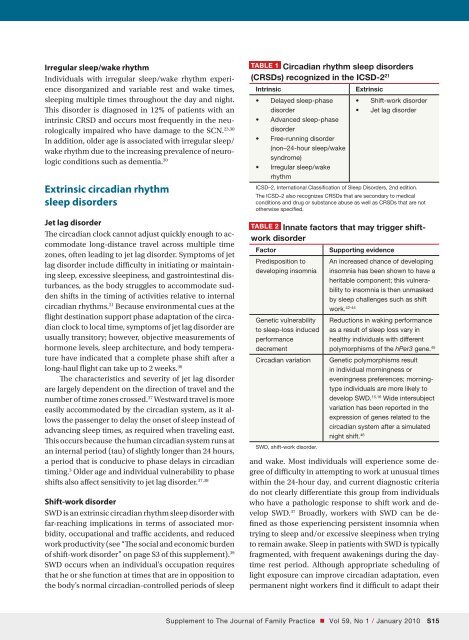SHIFT WORK DISORDER - myCME.com
SHIFT WORK DISORDER - myCME.com
SHIFT WORK DISORDER - myCME.com
- No tags were found...
Create successful ePaper yourself
Turn your PDF publications into a flip-book with our unique Google optimized e-Paper software.
Irregular sleep/wake rhythmIndividuals with irregular sleep/wake rhythm experiencedisorganized and variable rest and wake times,sleeping multiple times throughout the day and night.This disorder is diagnosed in 12% of patients with anintrinsic CRSD and occurs most frequently in the neurologicallyimpaired who have damage to the SCN. 23,30In addition, older age is associated with irregular sleep/wake rhythm due to the increasing prevalence of neurologicconditions such as dementia. 30Extrinsic circadian rhythmsleep disordersJet lag disorderThe circadian clock cannot adjust quickly enough to ac<strong>com</strong>modatelong-distance travel across multiple timezones, often leading to jet lag disorder. Symptoms of jetlag disorder include difficulty in initiating or maintainingsleep, excessive sleepiness, and gastrointestinal disturbances,as the body struggles to ac<strong>com</strong>modate suddenshifts in the timing of activities relative to internalcircadian rhythms. 21 Because environmental cues at theflight destination support phase adaptation of the circadianclock to local time, symptoms of jet lag disorder areusually transitory; however, objective measurements ofhormone levels, sleep architecture, and body temperaturehave indicated that a <strong>com</strong>plete phase shift after along-haul flight can take up to 2 weeks. 36The characteristics and severity of jet lag disorderare largely dependent on the direction of travel and thenumber of time zones crossed. 37 Westward travel is moreeasily ac<strong>com</strong>modated by the circadian system, as it allowsthe passenger to delay the onset of sleep instead ofadvancing sleep times, as required when traveling east.This occurs because the human circadian system runs atan internal period (tau) of slightly longer than 24 hours,a period that is conducive to phase delays in circadiantiming. 3 Older age and individual vulnerability to phaseshifts also affect sensitivity to jet lag disorder. 37,38Shift-work disorderSWD is an extrinsic circadian rhythm sleep disorder withfar-reaching implications in terms of associated morbidity,occupational and traffic accidents, and reducedwork productivity (see “The social and economic burdenof shift-work disorder” on page S3 of this supplement). 39SWD occurs when an individual’s occupation requiresthat he or she function at times that are in opposition tothe body’s normal circadian-controlled periods of sleepTable 1 Circadian rhythm sleep disorders(CRSDs) recognized in the ICSD-2 21Intrinsic• Delayed sleep-phasedisorder• Advanced sleep-phasedisorder• Free-running disorder(non–24-hour sleep/wakesyndrome)• Irregular sleep/wakerhythmExtrinsicShift-work disorderJet lag disorderICSD–2, International Classification of Sleep Disorders, 2nd edition.The ICSD–2 also recognizes CRSDs that are secondary to medicalconditions and drug or substance abuse as well as CRSDs that are nototherwise specified.Table 2 Innate factors that may trigger shiftworkdisorderFactorPredisposition todeveloping insomniaGenetic vulnerabilityto sleep-loss inducedperformancedecrementCircadian variationSWD, shift-work disorder.and wake. Most individuals will experience some degreeof difficulty in attempting to work at unusual timeswithin the 24-hour day, and current diagnostic criteriado not clearly differentiate this group from individualswho have a pathologic response to shift work and developSWD. 37 Broadly, workers with SWD can be definedas those experiencing persistent insomnia whentrying to sleep and/or excessive sleepiness when tryingto remain awake. Sleep in patients with SWD is typicallyfragmented, with frequent awakenings during the daytimerest period. Although appropriate scheduling oflight exposure can improve circadian adaptation, evenpermanent night workers find it difficult to adapt their••Supporting evidenceAn increased chance of developinginsomnia has been shown to have aheritable <strong>com</strong>ponent; this vulnerabilityto insomnia is then unmaskedby sleep challenges such as shiftwork. 42-44Reductions in waking performanceas a result of sleep loss vary inhealthy individuals with differentpolymorphisms of the hPer3 gene. 45Genetic polymorphisms resultin individual morningness oreveningness preferences; morningtypeindividuals are more likely todevelop SWD. 15,16 Wide intersubjectvariation has been reported in theexpression of genes related to thecircadian system after a simulatednight shift. 46Supplement to The Journal of Family Practice • Vol 59, No 1 / January 2010 S15
















